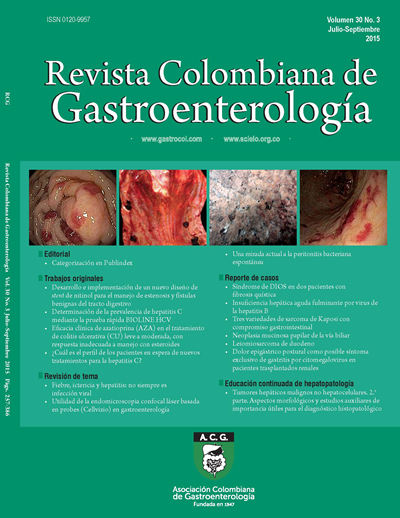¿Cuál es el perfil de los pacientes en espera de nuevos tratamientos para la hepatitis C?
DOI:
https://doi.org/10.22516/25007440.53Palabras clave:
Hepatitis C, resultado del tratamiento, interferón alfaResumen
Introducción: hasta hace poco, el tratamiento estándar de oro para la hepatitis C eran los interferones pegilados (Peg-IFN) en combinación con la ribavirina (RBV). Con la llegada de nuevos fármacos, se propuso evaluar los resultados del tratamiento y a los pacientes en espera de la nueva terapia.
Materiales y métodos: este estudio analítico transversal evaluó el resultado del tratamiento en individuos con hepatitis C crónica, y luego comparó a individuos que tienen experiencia en no responder al tratamiento basado en interferón (IFN) con individuos sin experiencia de tratamiento previo.
Resultados: el estudio incluyó 192 individuos. Entre 87 pacientes sometidos a tratamiento, se observaron bajas tasas de respuesta viral sostenida (RVS). La comparación de los 105 pacientes no tratados previamen- te y los 87 que habían recibido tratamiento con IFN previamente evidenció que entre los pacientes en espera de nuevas terapias, los individuos sin tratamiento previo presentaron mayor proporción de genotipo 1 (68% frente a 49%; p = 0,028), menores niveles de ALT (91,1 ± 73,0 frente a 126,0 ± 73,40 U/L; p = 017), de AST (70,1 ± 51,3 frente a 89,7 ± 47,40 U/L; p = 050), de GGT (85,3 ± 85,1 frente a 148,4 ± 123,9 U/L; p = 0,007) y menor proporción de fibrosis significativa (24,3 frente a 83,3; p <0,001).
Conclusiones: las tasas de RVS fueron bajas. La mayoría de posibles candidatos para el tratamiento por VHC no lo han tenido y son de genótipo-1 con histología leve.
Descargas
Referencias bibliográficas
European Association for the Study of the Liver. EASL recommendations on treatment of hepatitis C 2014. J Hepatol. 2014;61:373-95.
Bedossa P, Poynard T. An algorithm for the grading of acti- vity in chronic hepatitis C. The METAVIR Cooperative Study Group. Hepatology. 1996;24:289-93.
Pena SD, Di Pietro G, Fuchshuber-Moraes M, Genro JP, Hutz MH, Kehdy Fde S, et al. The genomic ancestry of indi- viduals from different geographical regions of Brazil is more uniform than expected. PLoS One. 2011;6:e17063.
Martins T, Machado DF, Schuelter-Trevisol F, Trevisol DJ, Vieira e Silva RA, Narciso-Schiavon JL, et al. Prevalence and factors associated with HCV infection among elderly individuals in a southern Brazilian city. Rev Soc Bras Med Trop. 2013;46:281-7.
Silveira L, Schiavon L de L, Silva KP, Lopes TB, Zaccaron
Mda R, Narciso-Schiavon JL. Clinical and epidemiolo- gical profile of blood donors with positive serology for viral hepatitis in southern Brazil. Rev Soc Bras Med Trop. 2011;44:269-73.
Zeuzem S, Feinman SV, Rasenack J, Heathcote EJ, Lai MY, Gane E, et al. Peginterferon alfa-2a in patients with chronic hepatitis C. N Engl J Med. 2000;343:1666-72.
Manns MP, McHutchison JG, Gordon SC, Rustgi VK, Shiffman M, Reindollar R, et al. Peginterferon alfa-2b plus ribavirin compared with interferon alfa-2b plus ribavirin for initial treatment of chronic hepatitis C: a randomised trial. Lancet. 2001;358:958-65.
Hadziyannis SJ, Sette H Jr., Morgan TR, Balan V, Diago M, Marcellin P, et al. Peginterferon-alpha2a and ribavirin com- bination therapy in chronic hepatitis C: a randomized study of treatment duration and ribavirin dose. Ann Intern Med. 2004;140:346-55.
Vigani AG, Goncales ES, Pavan MH, Genari F, Tozzo R, Lazarini MS, et al. Therapeutic effectiveness of biosimilar standard interferon versus pegylated interferon for chronic hepatitis C genotypes 2 or 3. Braz J Infect Dis. 2012;16:232-6.
Narciso-Schiavon JL, Schiavon L de L, Carvalho-Filho RJ, Sampaio JP, Batah PN, Barbosa DV, et al. Gender influence on treatment of chronic hepatitis C genotype 1. Rev Soc Bras Med Trop. 2010;43:217-23.
Silva GF, Polonio RJ, Pardini MI, Corvino SM, Henriques RM, Peres MN, et al. Using pegylated interferon alfa-2b and ribavirin to treat chronic hepatitis patients infected with hepa- titis c virus genotype 1: are non-responders and relapsers different populations? Braz J Infect Dis. 2007;11:554-60.
de Almeida PR, de Mattos AA, Amaral KM, Feltrin AA, Zamin P, Tovo CV, et al. Treatment of hepatitis C with peginterferon and ribavirin in a public health program. Hepatogastroenterology. 2009;56:223-6.
Di Marco V, Covolo L, Calvaruso V, Levrero M, Puoti M, et al. Who is more likely to respond to dual treatment with pegylated-interferon and ribavirin for chronic hepatitis C? A gender-oriented analysis. J Viral Hepat. 2013;20:790-800.
Kwo PY, Lawitz EJ, McCone J, Schiff ER, Vierling JM, Pound D, et al. Efficacy of boceprevir, an NS3 protease inhibitor, in combination with peginterferon alfa-2b and ribavirin in treatment-naive patients with genotype 1 hepatitis C infec- tion (SPRINT-1): an open-label, randomised, multicentre phase 2 trial. Lancet. 2010;376:705-16.
Jacobson IM, McHutchison JG, Dusheiko G, Di Bisceglie AM, Reddy KR, Bzowej NH, et al. Telaprevir for previously untreated chronic hepatitis C virus infection. N Engl J Med. 2011;364:2405-16.
Poordad F, McCone J Jr., Bacon BR, Bruno S, Manns MP, Sulkowski MS, et al. Boceprevir for untreated chronic HCV genotype 1 infection. N Engl J Med. 2011;364:1195-206.
Crespo J, Berenguer M, Perez F, Fernandez I, Gonzalez O, Barcena R, et al. Lead-in period and week 8 as predic- tive tools for response to boceprevir therapy: a retrospec- tive study of Spanish real clinical practice. Gastroenterol Hepatol. 2015. Pii:S0210-5705(15)00100-4.
Vo KP, Vutien P, Akiyama MJ, Vu VD, Ha NB, Piotrowski JI, et al. Poor sustained virological response in a multicenter real-life cohort of chronic hepatitis C patients treated with pegylated interferon and ribavirin plus telaprevir or boce- previr. Dig Dis Sci. 2015;60:1045-51.
Ministério da Saúde/CONITEC. Simeprevir, sofosbuvir e daclatasvir no tratamento da hepatite crônica tipo C e coin- fecções. Brasil: Ministério da Saúde/CONITEC; 2015.
Descargas
Publicado
Cómo citar
Número
Sección
Licencia
Aquellos autores/as que tengan publicaciones con esta revista, aceptan los términos siguientes:
Los autores/as ceden sus derechos de autor y garantizarán a la revista el derecho de primera publicación de su obra, el cuál estará simultáneamente sujeto a la Licencia de reconocimiento de Creative Commons que permite a terceros compartir la obra siempre que se indique su autor y su primera publicación en esta revista.
Los contenidos están protegidos bajo una licencia de Creative Commons Reconocimiento-NoComercial-SinObraDerivada 4.0 Internacional.



















